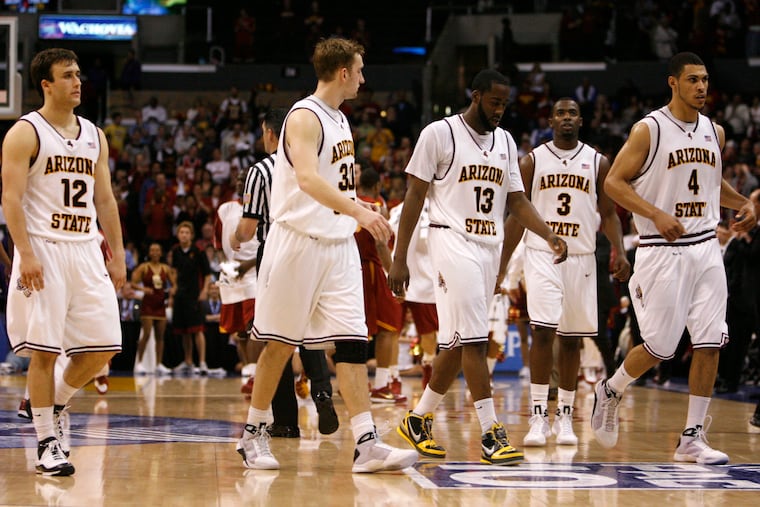James Harden is one of the NBA’s brightest stars — but Temple fans remember him differently
When Harden faced off against the Owls in the 2009 NCAA Tournament, Ryan Brooks held him to nine points on 1-of-8 shooting. Arizona State did pull off a win, however.

Shortly after James Harden was traded to the 76ers, Ryan Brooks found his phone flooded with text messages and tweet notifications reminding him about a 13-year-old NCAA Tournament game.
“I was like, ‘Ah, here it comes,’ ” Brooks said.
Harden, one of the league’s most prolific scorers, and Paul Millsap were acquired in a deal that sent Ben Simmons, Seth Curry, Andre Drummond, and two first-round draft picks to the Brooklyn Nets.
But those messages weren’t all about Philly getting a perennial All-Star. Many were recounting the time Brooks held Harden to nine points on 1 of 8 shooting from the field on March 20, 2009, in Temple’s 66-57 loss to Arizona State in the first round of the NCAA Tournament.
“Ryan Brooks did a terrific job guarding him,” said then-Temple coach Fran Dunphy. “[Harden] was a cut above where most others were. He was a real confident young man. To watch his maturation after that, he really knew how to play.”
That afternoon at American Airlines Arena in Miami, the sixth-seeded Sun Devils were in the driver’s seat for most of the game. They got 22 points each from point guard Derek Glasser and forward Jeff Pendergraph and led by as many as 13 midway through the first half, although the deficit never felt insurmountable for the Owls.
Just 17 seconds into the game, Harden put up his first shot and missed a three-pointer. In the first half, Harden went more than 14 minutes without taking a shot.
The Pac-10 Player of the Year missed his first seven attempts, which were a healthy combination of twos and threes. He was suffocated defensively each time down the floor.
“For any scorer like that, you’re just trying to make sure, one, they don’t get going early,” said Brooks, who played all 40 minutes in the loss, “and you try to limit the amount of easy baskets they have. Any player [who] gets a couple easy baskets and starts feeling comfortable with themselves, the basket starts getting a little bigger.”
Temple made a late charge, cutting the deficit to three in the final five minutes. Dionte Christmas scored a game-high 29 points in his last game for the Owls.
With 4 minutes, 44 seconds on the clock, Harden made one of two free-throw attempts to make it a four-point game. Then, finally, came his first and only field goal, and it was a big one. On Arizona State’s next possession, he sank a three and extended the lead to seven.
Colgate head coach Matt Langel, an assistant under Dunphy at the time, devised a fairly basic scouting plan for Harden: “Don’t let anything come easy,” Langel said. Langel knew this was important because Harden was “very good in transition, a very good playmaker.”
Glasser argued that while Harden struggled to get going offensively, he also wasn’t forcing up shots or taking extra initiative to score the ball.
“He wasn’t like, ‘Give me the ball, I need the ball,’ ” Glasser said. “Even if James was 1 for 17 with 10 turnovers, the team is going to guard him like he’s Kobe Bryant. … They still had to guard him like he was the best player on the floor.”
Brooks wanted to make Harden feel his presence each trip down the floor. He was Dunphy’s first recruit, making a name for himself as a defensive pest during his four-year career at Temple (2006-10). After playing professionally overseas for 10 years, he’s now back at his alma mater as the program’s lone graduate assistant, pursuing his master’s degree and teaching certification.
On Feb. 10 and the days leading up to the NBA trade deadline, Harden worked out at Rice University in Houston, where Glasser, his longtime teammate, is an assistant to Scott Pera, who coached them at Artesia High School and served as an assistant during their time at Arizona State.
Glasser shared a backcourt with Harden for many years and knows his maturation process as well as anyone. He was a high school sophomore when he met Harden, who was a freshman at the time. Glasser was originally committed to Southern California but decommitted with the intention of playing alongside Harden at Arizona State.
“When we were younger he just played through the flow of things and averaged 18 points on 12 or 13 shots,” Glasser said. “He just knows the game. He knows the angles. … He’s able to adapt in any situation.”
» READ MORE: Boxing and books: Daiyaan Butt doubles as a professional athlete and Temple student
The most prominent breakthrough in Harden’s game, according to Brooks, is his ability to take what the defense gives him. Harden’s high basketball IQ, combined with his innate strength, allows him to create for himself and his teammate in several ways.
“If a defender is forcing him left, he’ll go left. If a defender is forcing him right, he’ll go right,” Brooks said. “He’s able to get where he wants because he doesn’t really force the issue. When the game simplifies like that, it makes the game a lot easier.”
Which is what made Brooks’ defensive performance in 2009 so memorable. But he knows it would be a different story if they met on the court today.
”It’s funny [to hear] and it’s fun to entertain,” Brooks said, “but I’m someone who’s very aware that Harden is a much better player now and a much different player than he was at Arizona State.”